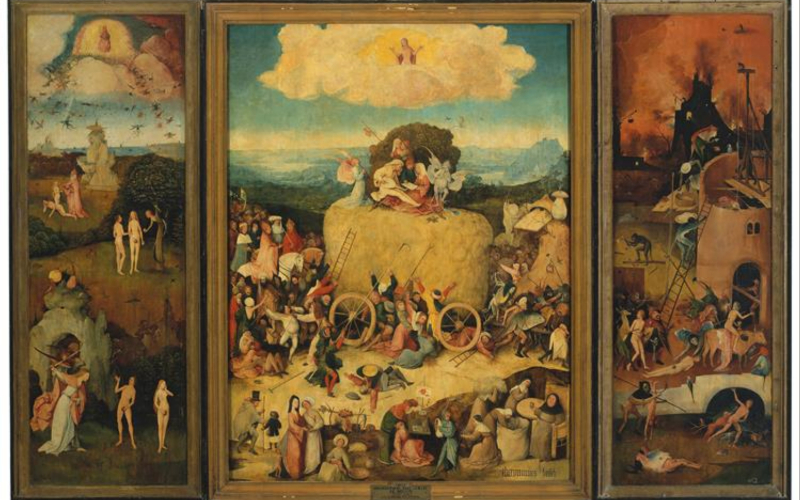Hieronymus Bosch painted The Haywain Triptych, a panel painting that is currently on display at the Museo del Prado in Madrid, Spain. Dendrochronological analysis has indicated a date of approximately 1516.
The wings are 147 x 66 centimeters in size, while the central panel, which is inscribed “Jheronimus Bosch,” spans 135 by 200 centimeters. A representation of Bosch’s The Wayfarer can be seen on the exterior shutters.
The painting was one of six that Philip II of Spain bought in 1570 and had transported to El Escorial four years later. It was then separated into three paintings and sold to the Marquis of Salamanca.
The left panel went to the Prado, the right one was returned to Escorial, and the center panel was purchased by Isabella II of Spain and moved to Aranjuez in 1848. In the latter institution, the triptych was fully reassembled in 1914. At the Escorial, there is a copy.
Like the majority of modern Dutch triptychs, the exterior of the shutters was also painted, but in this instance Bosch employed full colors rather than the more customary grisaille. When they are all closed together, they create a scene of a wayfarer. The man shoos the dog away with a stick.
Painting Depiction
The most recent interpretations suggest that this figure might represent the man who stays on his path despite being tempted by sins (such as lust, which might be represented by the two dancing shepherds) and by evil deeds happening around him.

The Garden of Earthly Delights and the Haywain triptych have a similar plot. The left panel depicts God creating Eve. But unlike the Garden, the panel has a story that unfolds in various moments. The rebellious angels are expelled from Heaven at the top, and while God sits on His throne, they transform into insects and break across the clouds. Underneath this, God fashions Eve from Adam’s rib.
The serpent then gives Adam and Eve an apple as they come across him and the tree. The angel finally ejects the two from the Garden of Eden at the bottom of the panel. Eve adopts a melancholy posture while looking to the right as Adam converses with the angel.
In addition to the lust-related crimes that rule the Garden of Earthly Delights, the centre panel depicts a massive wagon of hay surrounded by a great multitude of fools engaging in other sins. Bosch depicts Christ in the sky in the middle panel, not in the Garden. None of the other figures can see Christ looking down on the world as an angel perched atop the wagon looks to the sky and prays.
As shown on the right panel, the cart is drawn by infernal entities that take everyone to Hell. The rightward bow of the humans encircling the wagon provides the force for the viewer’s sight to travel with them on their journey.
The participants’ forward kinetic motion transports the observer from contemporary sin to pure agony in the regions of Hell. While the procession on the right side of this panel continues in a straight line with the wagon, a more obvious progression into damnation, the procession on the left side turns back into the middle ground.











